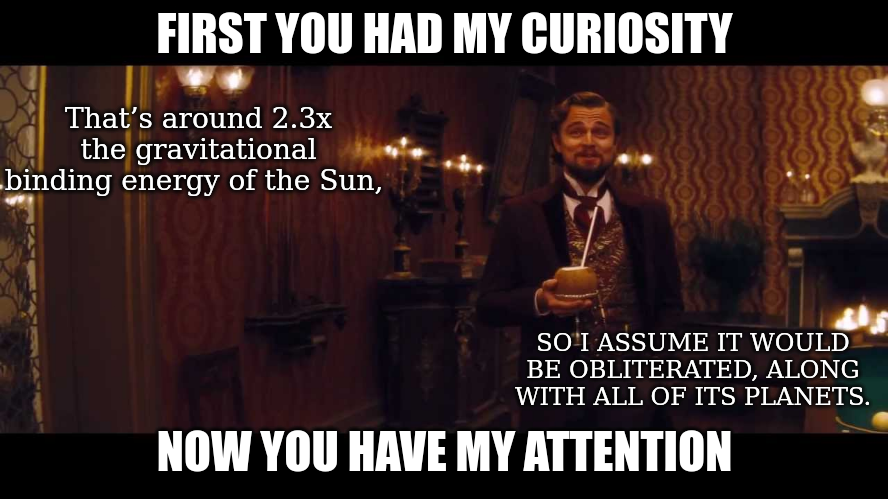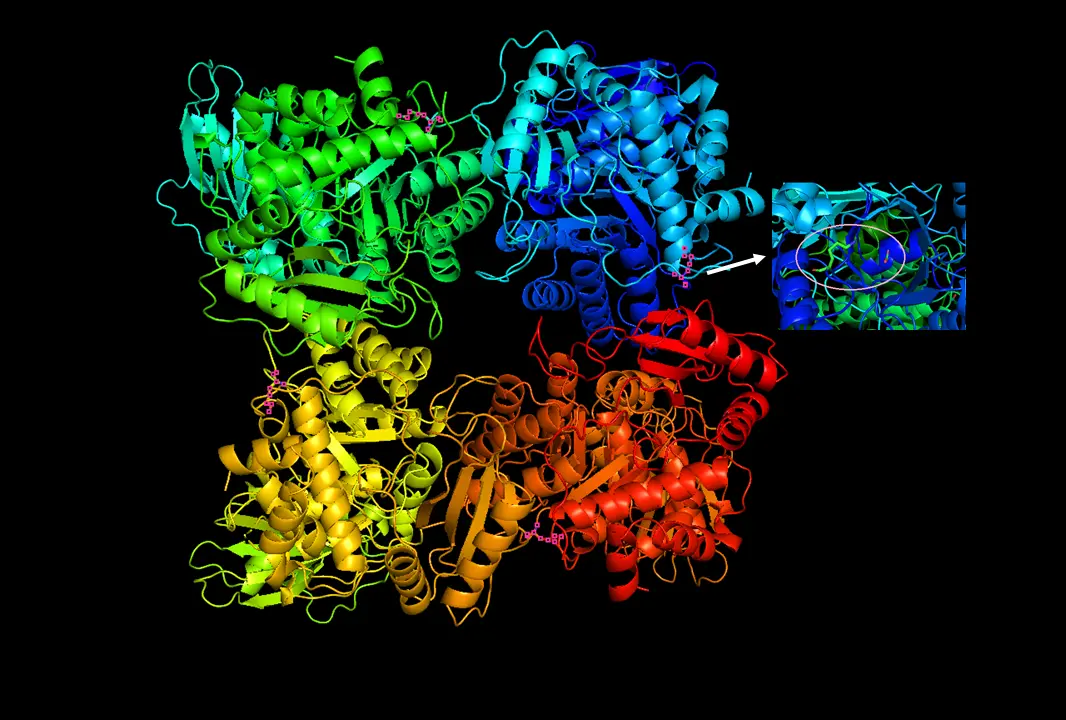or just a ‘poof’?
For a start, the planet wouldn’t actually collide with the sun on one piece - once the planet crosses the Roche limit it will break apart
if it “ran straight”, it wouldn’t have tangential speed, only radial.
All of the mass would still hit the sun, though.
Yeah, but single large mass hitting in one place vs stuff spread out vs planet forming a ring and deorbiting over months/years would affect the outcome
Practically, I’d think there wouldn’t be a huge effect beyond some CMEs - the mass of the earth is a rounding error compared to the sun - but I’m not a cosmologist
I tend to agree, but I also am not a cosmologist.
I agree, and I once dated a cosmetologist.
CME = coronal mass ejection
Sorry, but that’s wrong.
Roche limit applies in a circular orbit, tidal effects are irrelevant in a head on collision.
Famous example of a comet breaking up from entering Jupiter’s roche limit in a highly eccentric orbit (not circular). Spaghettification is also an example of how tidal forces still apply during a head on collision.
Eccentric orbit is still an orbit with tidal forces.
A dead in crash will stretch the sphere, but without angular momentum, it’s just a raindrop.
I mean the sun is pretty heckin huge

It would a situation of, “who threw that pebble?”
Ah, but at what speed?
The speed of love.
Now I’m imagining the type of event that could cause a planet to move at such a significant percent of c that you could disrupt the sun with it. I don’t think we’re gonna get a planet moving that fast. I think we’d be limited to stellar core remnants to get that kick in velocity.
That’s not how relativity works. Moving quickly relative to what? The planet might be moving slow relative to the local objects where it began its movement, but the local objects at it’s origination point were also moving at some speed, and the group of objects that the local group was in were also moving at some speed, etc etc. And likewise our sun isn’t stationary, it’s also moving relative to everything else, so you could just as easily say the planet is stationary but our sun was moving very quickly toward the stationary planet. There is no thing as an absolute slow/fast when you’re talking about bodies in space. There are tons of ways that a planet sized object could have a fraction-of-c speed relative to our sun.
And there are “rogue planets” out there. They aren’t held into any orbital system, they’re just flying free in empty space. So that part is true as well. It would be very unlikely that some of them AREN’T moving extremely quickly relative to the sun.
You can’t fool me with that label of “diameter”, I know that’s actually a trench with an exhaust port that if successfully fired into will cause a cascading failure
Okay so I forgot how big the sun is and had that absentminded mental picture moment of “oh it would make a big bang as something 3/4s the size of the sun would hit it”…
This picture was a very helpful reminder of just how out to lunch that thought was. Don’t trust your absent thoughts, folks 😅
it would be absolutely immensely catastrophic from the point of view of the planet … but for us and for the Sun, it would be nothing.
“oh look. A shadow.”
“Oh. I missed it.”
That always reminds me of force of impact. The bug hit the windshield just as hard as the windshield hit the bug, but the bug felt it more.
Are you planning something?
I would expect that the planets gravity while heading into the sun from outside the solar system would greatly disturb the existing planets and probably throw some of them into new orbits if not out of the solar system entirely.
New fear unlocked.
Big flare, seismic waves propagating on the surface, and POOF.
deleted by creator
A “planet” traveling at the speed of light would need to be composed entirely of photons, and (assuming an Earth-sized relativistic mass) would have 5.37x10^41 J of energy. That’s around 2.3x the gravitational binding energy of the Sun, so I assume it would be obliterated, along with all of its planets.

deleted by creator
At what speed?
Oooo, good question. What if it were traveling, relatively, at a fair percentage of C? Say 80 or 90%? What if it went not straight through the center, but say 30% off of center? Would any mass make a complete pass through, at that velocity? It’d be about 23% more dense from relativity, but countless YouTube videos about gun ammunition has taught me that velocity is the biggest factor in armor penetration. Would it blow a huge plume of plasma out there other side?
Dude, you just made this no doubt question far, far more interesting!
Fascinating. Lets say at 90% the planet spends 1 second inside the sun. Doesn’t seem like enough to melt the whole thing so it just keeps going, just a lot smaller. The core of the sun tried its best to push it back but gets pierced and the fusion reaction stops. Star killer??
Sun says yum.
don’t open this if you don’t want part of the three body problem series spoiled
Isn’t that the core element of one of the scorched earth fallback plans one of the wallfacers came up with? I thought it was supposed to have been roughly scientifically viable…? Or am I completely misremembering?
Incorrect. The plan was to send a signal to the sun to signal that our sun has a civilized planet, so that an unspecified alien race would blow the sun up to prevent humanity any further.
Would its impact create a solar flare? And if that flare was hurtling towards Earth, would it be more devastating than other solar storms we normally see?
Probably the biggest threat to us would be the rogue planet kicking some largish objects out in the Oort cloud into new orbits as it passed through. Some of the orbits would go into the inner solar system and could intersect with the Earth at some point.












